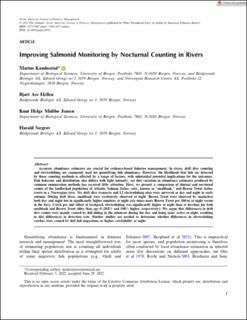| dc.contributor.author | Kambestad, Marius | |
| dc.contributor.author | Hellen, Bjart Are | |
| dc.contributor.author | Jensen, Knut Helge | |
| dc.contributor.author | Sægrov, Harald | |
| dc.date.accessioned | 2022-09-21T09:29:48Z | |
| dc.date.available | 2022-09-21T09:29:48Z | |
| dc.date.created | 2022-08-16T14:24:34Z | |
| dc.date.issued | 2022 | |
| dc.identifier.issn | 0275-5947 | |
| dc.identifier.uri | https://hdl.handle.net/11250/3020136 | |
| dc.description.abstract | Accurate abundance estimates are crucial for evidence-based fisheries management. In rivers, drift dive counting and electrofishing are commonly used for quantifying fish abundance. However, the likelihood that fish are detected by these counting methods is affected by a range of factors, with substantial potential implications for the outcomes. Fish behavior and distribution also differs with light intensity, yet diel variation in abundance estimates produced by common enumeration methods has received little attention. Here, we present a comparison of diurnal and nocturnal counts of the landlocked population of Atlantic Salmon Salmo salar, known as “småblank,” and Brown Trout Salmo trutta in a Norwegian river. Six drift dive transects and 12 electrofishing sites were surveyed at day and night in early autumn. During drift dives, småblank were exclusively observed at night. Brown Trout were observed by snorkelers both day and night but in significantly higher numbers at night (six times more Brown Trout per 100 m at night versus in the day). Catch per unit effort of backpack electrofishing was significantly higher at night than at daytime for both småblank and Brown Trout older than age 0 (202% and 108% higher, respectively). We argue that differences in drift dive counts were mainly caused by fish hiding in the substrate during the day and being more active at night, resulting in diel differences in detection rate. Further studies are needed to determine whether differences in electrofishing catches were caused by diel fish migrations or higher catchability at night. | en_US |
| dc.language.iso | eng | en_US |
| dc.publisher | Wiley | en_US |
| dc.rights | Navngivelse 4.0 Internasjonal | * |
| dc.rights.uri | http://creativecommons.org/licenses/by/4.0/deed.no | * |
| dc.title | Improving Salmonid Monitoring by Nocturnal Counting in Rivers | en_US |
| dc.type | Journal article | en_US |
| dc.type | Peer reviewed | en_US |
| dc.description.version | publishedVersion | en_US |
| dc.rights.holder | Copyright 2022 the authors | en_US |
| cristin.ispublished | true | |
| cristin.fulltext | original | |
| cristin.qualitycode | 1 | |
| dc.identifier.doi | 10.1002/nafm.10811 | |
| dc.identifier.cristin | 2043491 | |
| dc.source.journal | North American Journal of Fisheries Management | en_US |
| dc.identifier.citation | North American Journal of Fisheries Management. 2022. | en_US |

